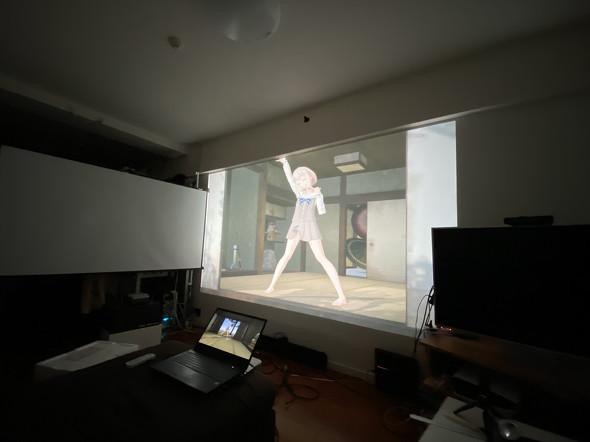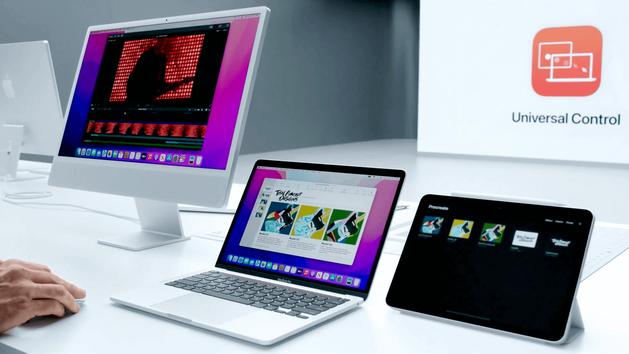On the desk is a box-like display made by combining a notebook PC and a small monitor. The display shows 3D characters dancing, but if you change the viewing angle, it looks as if they are actually dancing on the desk. A video of the incident has gone viral on Twitter.
There were reactions such as "It looks like there is a person in the box" and "I have no idea how it works", and as of 7:00 pm on August 27th, it has collected about 25,000 likes.
This was developed by freelance engineer ROBA (@vjroba). It is said that he created software "Portalgraph" to reproduce this mechanism on various other displays and projectors.
We asked ROBA about how they create 3D images.
Face tracking with Vive tracker Use of 3D glasses supports stereoscopic viewing
When using this software, the person who actually sees the video on the spot is the position tracking of HTC Taiwan Wear the device "Vive Tracker" on your head. Images are output to the monitor according to the position of the head obtained by the tracker and the positional relationship between the monitor and projector. In the video at the beginning, a tracker is attached to the camera, and the image is changed according to the position of the camera.

When you actually see it, you can use 3D glasses to support stereoscopic viewing. The user wears 3D glasses of the anaglyph method (so-called red-blue glasses) or the liquid crystal shutter method (a method of switching the image seen by the left and right eyes at each fixed frame when the sensor detects light), and the image side responds accordingly. By displaying content, a sense of depth can be felt with both eyes.
There is no need to use your own hardware, including 3D projectors and screens, and the feature is that you can play back images that look three-dimensional with just off-the-shelf products. In the case of the image at the beginning, 3D glasses are required to see it with both eyes, but it is said that the stereoscopic effect can be obtained with one eye even with the naked eye.
Inspired by Sony's ``spatial reproduction display'' ``I want to do it on a bigger screen at a lower price''
According to Mr. ROBA, Portalgraph was originally a display developed by Sony that allows stereoscopic viewing with the naked eye. When he saw the "ELF-SR1", he thought, "Isn't it possible to do the same thing with a cheaper, larger screen?" Based on this development history, Portalgraph's strength lies in its ability to display images on large screens.
Image when using a projector"The ELF-SR1 is very good, but the screen is small at 15.6 inches. I bought a super single focus projector and tried it (on a big screen). , this is good, and I thought I'd try making it seriously."
Because it is possible to project images that look three-dimensional with only ready-made products, one of its strengths is that the cost of arranging a set of equipment is relatively low.
"In 1997, the University of Tokyo created a device called 'CABIN'. This was installed inside a building, and by illuminating (images) from the outside with a projector, it was possible to A box-shaped VR space with five screens.It seems that this device used one computer that costs 10 to 20 million for each screen.(Compared to CABIN) 3D that I first bought for Portalgraph A projector costs 45,000 yen, which is tens or hundreds of times less.”
On the other hand, like the video that became a hot topic on Twitter, he feels that even a small display like a laptop can be used in a unique way.
``When I tried to show the video on the same 15.6 inch display as the ELF-SR1, the experience was similar to the ELF-SR1. came back after a full circle."
If there are multiple 3D projectors, it will be a super big screen?Related articles
1|2Next pageTo read more, you must agree to the terms of use for comments and register for "ITmedia ID" and "ITmedia NEWS Anchor Desk Magazine"

![EVsmart blog Toyota's electric car "bZ4X" that makes you feel comfortable with electric cars and quick chargers / No% display of battery level [Editorial department] Popular articles Recent posts Category](https://website-google-hk.oss-cn-hongkong.aliyuncs.com/drawing/article_results_9/2022/3/9/752542064665dc2bd7addbc87a655694_0.jpeg)
![Lenovo's 8.8 inch one-handed tab "Legion Y700" full specs released! [Is the price in the 40,000 yen range?]](https://website-google-hk.oss-cn-hongkong.aliyuncs.com/drawing/article_results_9/2022/3/9/207e1be231154e91f34c85b4b1d2126c_0.jpeg)

